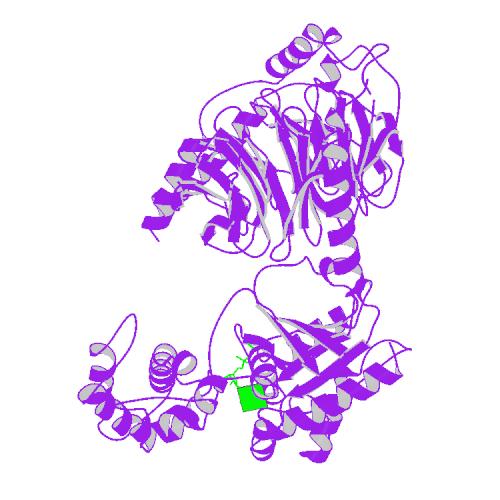GNG2
| Guanine nucleotide binding protein (G protein), gamma 2 | |||||||||||||
|---|---|---|---|---|---|---|---|---|---|---|---|---|---|
 PDB rendering based on 1gg2. | |||||||||||||
| |||||||||||||
| Identifiers | |||||||||||||
| Symbols | GNG2 ; | ||||||||||||
| External IDs | Template:OMIM5 Template:MGI HomoloGene: 40715 | ||||||||||||
| |||||||||||||
| Orthologs | |||||||||||||
| Template:GNF Ortholog box | |||||||||||||
| Species | Human | Mouse | |||||||||||
| Entrez | n/a | n/a | |||||||||||
| Ensembl | n/a | n/a | |||||||||||
| UniProt | n/a | n/a | |||||||||||
| RefSeq (mRNA) | n/a | n/a | |||||||||||
| RefSeq (protein) | n/a | n/a | |||||||||||
| Location (UCSC) | n/a | n/a | |||||||||||
| PubMed search | n/a | n/a | |||||||||||
Guanine nucleotide binding protein (G protein), gamma 2, also known as GNG2, is a human gene.[1]
Heterotrimeric G proteins play vital roles in cellular responses to external signals. The specificity of a G protein-receptor interaction is primarily mediated by the gamma subunit.[supplied by OMIM][1]
References
Further reading
- Pumiglia KM, LeVine H, Haske T; et al. (1995). "A direct interaction between G-protein beta gamma subunits and the Raf-1 protein kinase". J. Biol. Chem. 270 (24): 14251–4. PMID 7782277.
- Tsukada S, Simon MI, Witte ON, Katz A (1994). "Binding of beta gamma subunits of heterotrimeric G proteins to the PH domain of Bruton tyrosine kinase". Proc. Natl. Acad. Sci. U.S.A. 91 (23): 11256–60. PMID 7972043.
- Yan K, Kalyanaraman V, Gautam N (1996). "Differential ability to form the G protein betagamma complex among members of the beta and gamma subunit families". J. Biol. Chem. 271 (12): 7141–6. PMID 8636150.
- De Waard M, Liu H, Walker D; et al. (1997). "Direct binding of G-protein betagamma complex to voltage-dependent calcium channels". Nature. 385 (6615): 446–50. doi:10.1038/385446a0. PMID 9009193.
- Kostenis E, Conklin BR, Wess J (1997). "Molecular basis of receptor/G protein coupling selectivity studied by coexpression of wild type and mutant m2 muscarinic receptors with mutant G alpha(q) subunits". Biochemistry. 36 (6): 1487–95. doi:10.1021/bi962554d. PMID 9063897.
- Qin N, Platano D, Olcese R; et al. (1997). "Direct interaction of gbetagamma with a C-terminal gbetagamma-binding domain of the Ca2+ channel alpha1 subunit is responsible for channel inhibition by G protein-coupled receptors". Proc. Natl. Acad. Sci. U.S.A. 94 (16): 8866–71. PMID 9238069.
- Ong OC, Hu K, Rong H; et al. (1997). "Gene structure and chromosome localization of the G gamma c subunit of human cone G-protein (GNGT2)". Genomics. 44 (1): 101–9. doi:10.1006/geno.1997.4814. PMID 9286705.
- Nishida K, Kaziro Y, Satoh T (1999). "Association of the proto-oncogene product dbl with G protein betagamma subunits". FEBS Lett. 459 (2): 186–90. PMID 10518015.
- Carman CV, Barak LS, Chen C; et al. (2000). "Mutational analysis of Gbetagamma and phospholipid interaction with G protein-coupled receptor kinase 2". J. Biol. Chem. 275 (14): 10443–52. PMID 10744734.
- Modarressi MH, Taylor KE, Wolfe J (2000). "Cloning, characterization, and mapping of the gene encoding the human G protein gamma 2 subunit". Biochem. Biophys. Res. Commun. 272 (2): 610–5. doi:10.1006/bbrc.2000.2832. PMID 10833460.
- Evanko DS, Thiyagarajan MM, Siderovski DP, Wedegaertner PB (2001). "Gbeta gamma isoforms selectively rescue plasma membrane localization and palmitoylation of mutant Galphas and Galphaq". J. Biol. Chem. 276 (26): 23945–53. doi:10.1074/jbc.M101154200. PMID 11294873.
- Yu Y, Zhang C, Zhou G; et al. (2001). "Gene expression profiling in human fetal liver and identification of tissue- and developmental-stage-specific genes through compiled expression profiles and efficient cloning of full-length cDNAs". Genome Res. 11 (8): 1392–403. doi:10.1101/gr.175501. PMID 11483580.
- Lowry WE, Huang XY (2002). "G Protein beta gamma subunits act on the catalytic domain to stimulate Bruton's agammaglobulinemia tyrosine kinase". J. Biol. Chem. 277 (2): 1488–92. doi:10.1074/jbc.M110390200. PMID 11698416.
- Strausberg RL, Feingold EA, Grouse LH; et al. (2003). "Generation and initial analysis of more than 15,000 full-length human and mouse cDNA sequences". Proc. Natl. Acad. Sci. U.S.A. 99 (26): 16899–903. doi:10.1073/pnas.242603899. PMID 12477932.
- Cuello F, Schulze RA, Heemeyer F; et al. (2003). "Activation of heterotrimeric G proteins by a high energy phosphate transfer via nucleoside diphosphate kinase (NDPK) B and Gbeta subunits. Complex formation of NDPK B with Gbeta gamma dimers and phosphorylation of His-266 IN Gbeta". J. Biol. Chem. 278 (9): 7220–6. doi:10.1074/jbc.M210304200. PMID 12486123.
- Melliti K, Grabner M, Seabrook GR (2003). "The familial hemiplegic migraine mutation R192Q reduces G-protein-mediated inhibition of P/Q-type (Ca(V)2.1) calcium channels expressed in human embryonic kidney cells". J. Physiol. (Lond.). 546 (Pt 2): 337–47. PMID 12527722.
- Wolfe JT, Wang H, Howard J; et al. (2003). "T-type calcium channel regulation by specific G-protein betagamma subunits". Nature. 424 (6945): 209–13. doi:10.1038/nature01772. PMID 12853961.
- Niu J, Profirovic J, Pan H; et al. (2003). "G Protein betagamma subunits stimulate p114RhoGEF, a guanine nucleotide exchange factor for RhoA and Rac1: regulation of cell shape and reactive oxygen species production". Circ. Res. 93 (9): 848–56. doi:10.1161/01.RES.0000097607.14733.0C. PMID 14512443.
- Ota T, Suzuki Y, Nishikawa T; et al. (2004). "Complete sequencing and characterization of 21,243 full-length human cDNAs". Nat. Genet. 36 (1): 40–5. doi:10.1038/ng1285. PMID 14702039.
- Doering CJ, Kisilevsky AE, Feng ZP; et al. (2004). "A single Gbeta subunit locus controls cross-talk between protein kinase C and G protein regulation of N-type calcium channels". J. Biol. Chem. 279 (28): 29709–17. doi:10.1074/jbc.M308693200. PMID 15105422.
| This protein-related article is a stub. You can help Wikipedia by expanding it. |